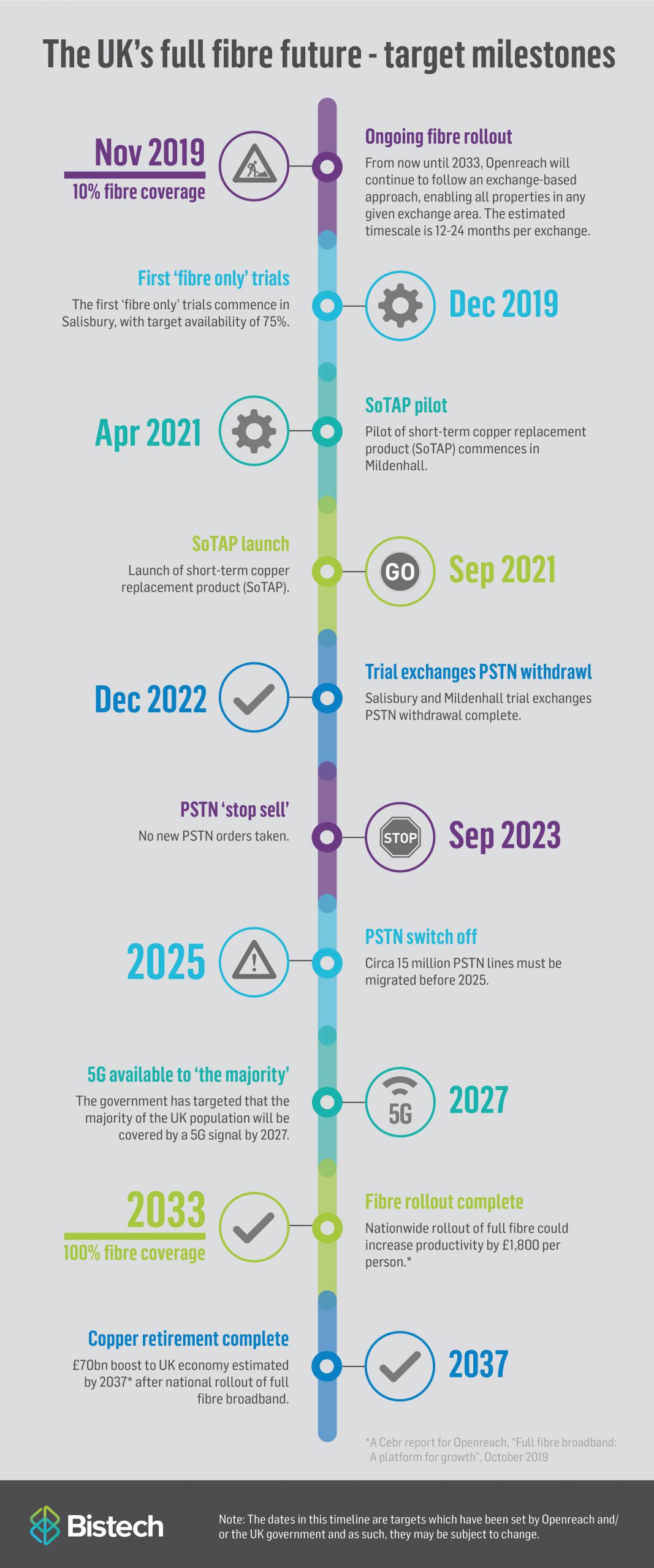Your essential guide to full fibre, 5G and the end of PSTN
Technology is creating exciting opportunities for companies to grow and evolve, with digital and cloud transformation strategies at the fore. Of course, to fully realise the benefits, fast, reliable connectivity to the cloud is essential. For the UK to compete in a cloud-first global economy, we need a communications infrastructure that delivers high speed fixed and mobile connectivity – everywhere.
But the UK’s existing copper infrastructure is over 100 years old and was not designed for this purpose. Replacing it is a huge undertaking and with the total cost of full fibre roll-out estimated at £30 billion, significant investment is required from both the government and the private sector. (1)
The UK government has set a target date of 2033 for full fibre availability. It believes that this target is achievable through a policy and regulatory approach that will create the market conditions to attract private sector investment and promote competition alongside government investment.
Our journey to full fibre
It’s clear that the government, the regulators, Openreach, and the wider comms industry all have much work to do before the legacy copper networks can be replaced. The infographic below highlights the key stages.

Why fibre?
The benefit of access to increased bandwidth is a given. But from a strategic perspective, there are many other factors driving the demand…
Reliability and availability
Full fibre networks are more reliable, which reduces maintenance costs compared to copper lines. For example, Ofcom estimated that there were faults on over 12% of Openreach’s copper lines in 2015.(2) So with a focus on fibre, rather than copper repairs, operators can continually improve their network, leading to efficiency savings, better performance and reduced downtime for businesses.
Next-generation mobile experience
With the government targeting 5G availability for most of the country by 2027(1), the rollout of 5G is playing a key role in the overall investment of fibre networks across the UK. Due to the high bandwidth requirement of 5G, Mobile Network Operators (MNOs) are investing heavily in their networks to support the inevitable demand, providing a significant contribution to UK fibre infrastructure.
Connected via high capacity fibre networks, 5G offers ten times the data speeds of 4G, five times the latency performance, and the ability to connect one million devices per square kilometre (compared to 200 on 4G).(3) These capabilities will enable us to transmit and process information faster and connect our workforce more efficiently, radically changing the way we live and work.
Economic growth and productivity
Pervasive access to high speed connectivity is expected to have a significant impact on the broader economy. There are widespread reports on the economic impact of fibre and 5G, for example:
- A study undertaken for Cityfibre predicts that the total economic impact of deploying full fibre across 100 distinct UK city and towns, could increase GDP by £120 billion over a 15 year period (4)
- A report for Barclays Corporate Banking predicts that national 5G infrastructure could increase aggregate business revenues by between £8.3 billion and £15.7 billion by 2025 (5)
Enabling future technologies
Emerging technologies such as Artificial Intelligence (AI), robotics and the Internet of Things (IoT) are coming together to make futuristic capabilities such as self-driving cars, autonomous delivery drones, augmented reality systems and smart cities a reality. However, these services will only be possible in an environment with reliable, high bandwidth, low latency connectivity.
What does this mean to UK businesses?
Competition promotes choice
To achieve high-speed access for all, Openreach cannot do it alone. ‘Alt-Net’ fibre providers such as Virgin Media, CityFibre and Fibre Nation (to name a few), will all be important contributors to a full fibre UK.
Essentially, Openreach will lose its monopoly on physical connectivity and increased choice will create a more competitive market, bringing costs down. So, to achieve the highest bandwidths at the most competitive cost, it will be crucial to work with a service provider that offers access to a wide choice of ‘last mile’ fibre infrastructure providers.
Fixed infrastructure and 5G
Underpinned by fibre infrastructure, 5G and mobile connectivity should not be seen as a replacement to fixed connectivity, but rather a complementary technology. As well as enhancing the user experience for those on the move, mobile data connectivity can be ideal for short term deployments such as temporary ‘pop-up’ stores. Similarly, due to the short lead times, it’s useful for activating sites that need to be up and running while the primary fixed connectivity is being provisioned. It can also be a favourable option for resilience due to its diversity to the fixed networks.
PSTN retirement
It’s over five years since BT and Openreach started referring to the PSTN network as ‘legacy’. VoIP is now a mature technology and seen as the de facto method of delivering voice. However, many businesses are not yet harnessing the benefits of VoIP and continue to use legacy PSTN and ISDN services.
With around 15 million lines still needing to be switched off by 2025, the UK is set to see a significant uplift in the take-up of VoIP services between now and then.
The road ahead
UK businesses have an exciting opportunity to capitalise on the latest technologies over the next few years, as these fundamental changes in comms infrastructure become a reality. To take full advantage, it’s essential to partner with an established, independent provider that can offer industry insight and expertise every step of the way.
Bistech partners with all UK ‘last mile’ fibre infrastructure providers. And as one of only 29 respondents to last year’s UK wide industry consultation with Openreach, we are actively involved in the planning of PSTN and ISDN withdrawal. If you need help future-proofing your business, give us a call today – 03330 11 22 55.
References
(1) Department for Digital, Culture, Media & Sport, ‘Future Telecoms Infrastructure Review’, 2019
(2) Ofcom, ‘Initial conclusions from the Strategic Review of Digital Communications’, 2016
(3) O2 Business, ‘5G: A new kind of connectivity’, 2019
(4) Regeneris, ‘The Economic Impact of Full Fibre Infrastructure in 100 UK Towns and Cities’, 2018
(5) Barclays, ‘5G: A transformative technology’, 2019



